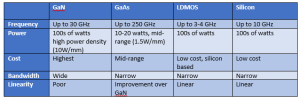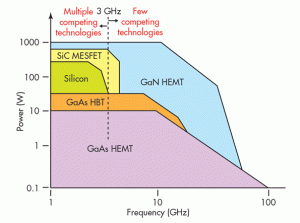GaN technology has been improving radio frequency (RF) systems since the early 1990’s. It’s ability to support high frequency, wide bandwidths, and high-power density make it invaluable in any market requiring high performance in a small form factor.
When compared with other semiconductor technologies such as Gallium Arsenide (GaAs), Laterally Diffused Metal Oxide (LDMOS), and Silicon, GaN continues to meet the needs of our miniaturized RF power amplifiers (PAs). GaN’s high power density and high thermal conductivity allow the semiconductor to dissipate heat more efficiently than other semiconductor technologies. This means a GaN device has the advantage of operating at a given output power at lower temperatures, greater reliability, higher breakdown voltages, and higher Mean Time Between Failure (MTBF) compared to GaAs, LDMOS, and Silicon. This is critical to many applications, especially those operating within size, weight, and power (SWaP) constraints. For example, GaN can relieve the burden on UAV and airborne system integrators who are implementing high power PAs into payloads and wing tips with stringent thermal management requirements. Also, for wide frequency bandwidth applications, GaN allows for smaller matching circuits due to being inherently broadband. Impedance match on a GaN PA can be accomplished with less components, because impedance translation to 50 Ohms is simpler, especially over a broad frequency range. The impedance of a GaN transistor does not shift over frequency as drastically as other technologies, allowing for fewer components to satisfy the necessary impedance matching. Therefore, less components also contribute to a smaller size. Table 1 shows a comparison of GaN versus the other technologies.

Table 1. Semiconductor Technology Performance Comparison
While some may draw attention to GaN being a high cost solution, GaN pricing has started decreasing with the semiconductor’s infiltration to the market, especially with the drive towards 5G. In the past few years, our engineers have seen prices drop from $250 a unit to $150 per unit.
One of the drawbacks to GaN is its linear performance. Linear PAs are needed for complex modulations that are non-constant envelope (digital waveforms) such as OFDM where multiple carriers are in the waveform. GaN requires significant power back off from the Psat of the amplifier to achieve the linearity you may see in LDMOS, Silicon, and GaAs. Power back-off can reduce the efficiency of the PA and the range extension due to the lower backed off power operation. An alternative solution to reduce the required power back off is NuWaves’ Power Amplifier Linearizer Module (PALM). This technology uses cost effective, broadband linearization techniques to improve GaN PA linearity. The required power back off is significantly reduced allowing for the power amplifier to operate closer to Psat and at greater efficiency. If system integrators can identify requirements early in the design phase, then design engineers can embed a linear PA solution like the NuWaves’ PALM. This allows the benefits of GaN to be utilized for wideband performance, high power density, small form factor, high thermal conductivity while also improving data throughput and range extension. This linearizer capability is currently embedded in several of our bidirectional amplifier (BDA) designs, and is integrated when applications require more linear operation. Linear PAs have been a large focus for NuWaves and continue to stay on our product roadmap as we build our advanced miniaturized RF modules.
In Figure 1, you will see a graphical depiction of the trade-offs of power vs. frequency capability. GaN technology is in its infancy and there is still a rise in funding to investigate its performance. Of note, GaN has been able to replace tube transistors in very high-power applications. We expect GaN technology to continually advance and have found its wideband performance superior to GaAs, LDMOS, and Silicon.

Figure 1. Graphical Depiction of Bandwidth Power vs. Frequency Capability1
We look forward to see what new products and research GaN helps us develop next! NuWaves RF Solutions has developed a wide variety of off-the-shelf RF power amplifiers with GaN technology. Frequency ranges are available from UHF through C-band with output power levels ranging from 5 to 100 W. All NuPower™ Power Amplifiers (PAs) and NuPower Xtender™ Bidirectional Amplifiers (BDAs) are designed, built, and tested in-house under NuWaves’ Quality Management System (QMS) certified to AS9100:2016 and ISO 9001-2015 standards, which ensures that each product arrives on-time and defect-free. Most models are in-stock, and are available for same-day shipment on orders placed before 2 p.m. NuWaves also boasts a full suite of state-of-the-art design and simulation tools, test and measurement equipment, prototyping equipment and a full-scale production facility to provide custom solutions to your specifications. Contact NuWaves today to extend the range of your communications systems and don’t forget to check out our RF Amplifiers and Frequency Converters.
References:
- Oliver, S. (2014, October 01). Optimize a Power Scheme for these Transient Times. Retrieved August 05, 2019, from https://www.electronicdesign.com/power/optimize-power-scheme-these-transient-times



Comments are closed